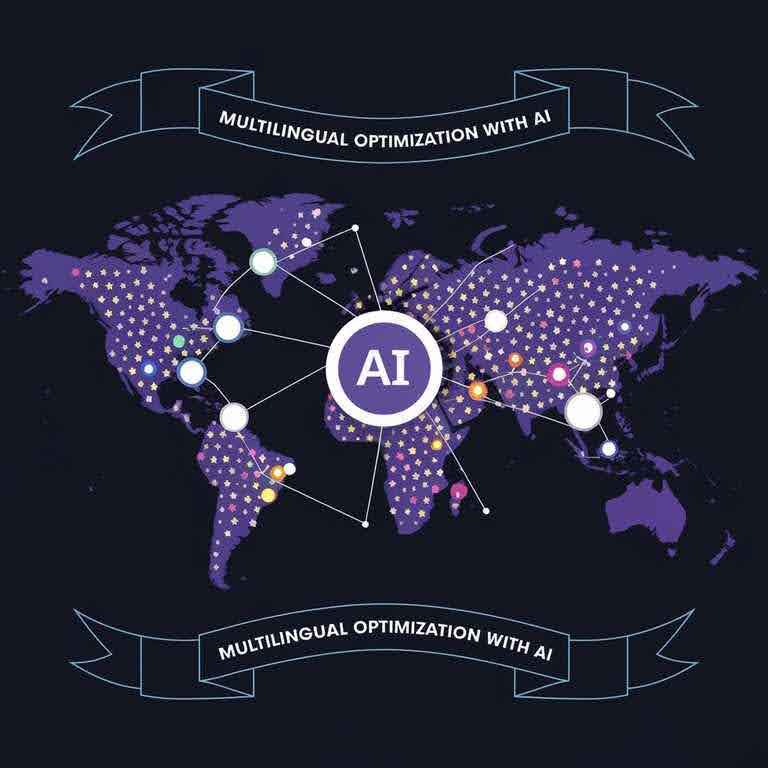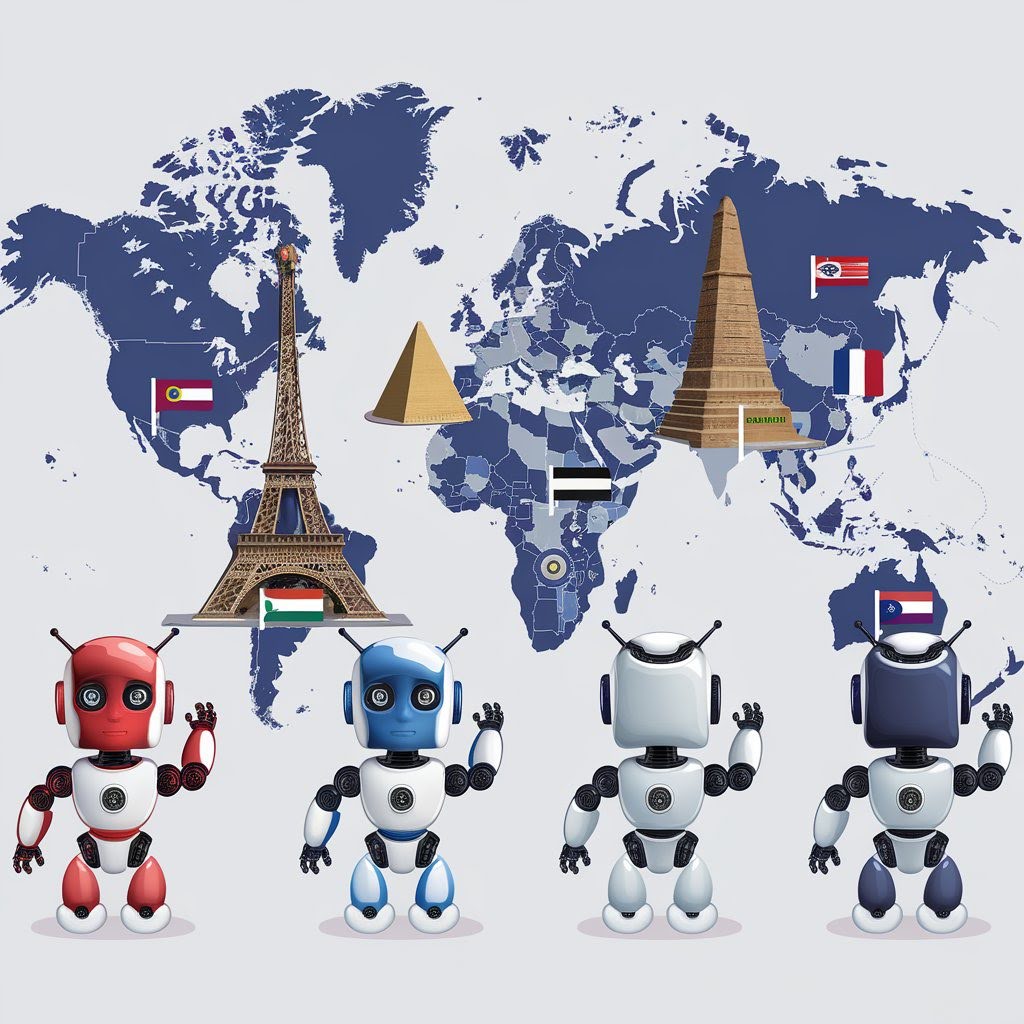The rapid growth of e-commerce has made it essential for businesses to expand beyond local markets and reach international audiences. However, breaking into global markets requires more than just translating product descriptions—it demands a comprehensive multilingual SEO strategy. Artificial intelligence (AI) is revolutionizing this process by automating keyword research, content optimization, and localization, making it easier for businesses to scale their global reach efficiently.
This guide will explore how AI enhances multilingual e-commerce SEO, the tools and techniques that make it possible, and how businesses can leverage AI to optimize their product listings for multiple languages and regions.

Key Benefits of AI for Multilingual E-commerce SEO
- Automated Keyword Research – AI-powered tools analyze search behavior in different languages and suggest high-performing keywords.
- Efficient Content Localization – AI helps adapt product descriptions and metadata to different languages and cultures without losing context.
- Improved User Experience – AI-driven personalization tailors content to specific regions and customer preferences.
- Scalability – Businesses can quickly optimize product listings for multiple markets without requiring extensive manual input.
Understanding AI for Multilingual E-commerce SEO
What is AI for Multilingual E-commerce SEO?
AI for multilingual e-commerce SEO refers to the use of artificial intelligence to optimize product listings and website content for multiple languages, ensuring that products rank highly in search engines across different regions. AI-driven SEO involves:
- Machine learning algorithms that analyze search trends and customer behavior.
- Natural language processing (NLP) that helps AI understand and generate content in multiple languages.
- Automation tools that streamline keyword research, content creation, and technical SEO.
Feature | Traditional SEO | AI-Driven SEO |
Keyword Research | Manual research for each language | AI identifies high-ranking keywords automatically |
Content Translation | Requires human translators | AI-powered NLP adapts content for different languages |
Metadata Optimization | Manually updated for each language | AI generates optimized metadata for multilingual content |
Technical SEO | Hreflang tags and URL structure managed manually | AI automates implementation and error detection |
Why AI is Essential for Multilingual E-commerce
AI enhances multilingual e-commerce SEO by eliminating inefficiencies and ensuring content is optimized for different languages without compromising quality. Key reasons why AI is essential include:
- Speed and Automation – AI can quickly process vast amounts of data, optimizing multilingual content in real-time.
- Accuracy in Translation and Localization – AI ensures that translated content aligns with cultural nuances and user intent.
- Improved Ranking Potential – AI-driven insights help businesses target high-ranking keywords for different regions.
- Cost Efficiency – Automating SEO tasks reduces the need for extensive human intervention, saving time and resources.

AI-Powered Keyword Research for Multilingual SEO
Finding High-Impact Keywords in Multiple Languages
Keyword research is one of the most critical aspects of multilingual SEO, and AI-powered tools make this process more effective by:
- Analyzing local search trends to identify the most relevant keywords for different languages.
- Using AI-driven keyword clustering to group similar search terms and uncover search intent.
- Leveraging predictive analytics to forecast which keywords will gain traction in different markets.
Best AI Tools for Multilingual Keyword Research
Tool | Features | Supported Languages |
Google Keyword Planner | Provides search volume and competition data | Multiple |
Ahrefs | Advanced keyword suggestions with difficulty analysis | Multiple |
SEMrush | AI-powered keyword intent analysis | Multiple |
DeepL & ChatGPT | AI-assisted keyword translations and adaptations | Multiple |
AI vs. Human Keyword Optimization
While AI significantly enhances multilingual keyword research, human oversight is still necessary to ensure cultural relevance.
Aspect | AI Optimization | Human Optimization |
Speed | Instant keyword suggestions | Time-consuming research |
Accuracy | May misinterpret contextual meanings | Ensures culturally appropriate keywords |
Scalability | Can analyze thousands of keywords at once | Limited by manual effort |
AI should be used in combination with human expertise to refine keyword selection and ensure proper context and cultural relevance.
AI-Driven Content Optimization for Multilingual E-commerce
Generating High-Quality Multilingual Product Descriptions
Product descriptions are the heart of an e-commerce store. They inform, persuade, and help products rank in search engines. But translating them word-for-word isn’t enough. AI helps by creating descriptions that are not just translated but localized to resonate with different audiences.
How AI Enhances Product Descriptions
- Context-aware translations – AI understands context, ensuring the meaning stays intact.
- SEO-friendly adaptations – AI suggests optimized keywords for each language.
- Consistency across languages – AI maintains a unified brand voice worldwide.
- Faster content creation – AI automates the process, saving time and effort.
Example: AI vs. Traditional Translation
Feature | Traditional Translation | AI-Powered Optimization |
Speed | Slow, manual process | Instant adaptation |
Keyword Integration | Needs manual SEO adjustments | AI inserts keywords naturally |
Cultural Adaptation | Limited unless a local expert is involved | AI analyzes local preferences |
Scalability | Not scalable for large stores | Works for thousands of products at once |
Best Practices for AI-Generated Product Descriptions
- Use AI-generated drafts, then refine – AI speeds up the process, but human editing ensures accuracy.
- Include regional preferences – For example, color names vary: “burgundy” in English might be “Bordeaux” in French.
- Test different versions – A/B testing helps determine which descriptions convert better.
- Keep it natural – Avoid robotic-sounding text by blending AI suggestions with a human touch.

AI for Optimizing Product Titles and Meta Tags
Titles and meta tags are key to visibility. To rank well in multiple languages, they must be concise, descriptive, and keyword-rich. AI helps by analyzing search intent and suggesting the best structure for each language.
How AI Optimizes Titles and Meta Tags
- Identifies high-performing title formats – AI analyzes successful competitors and suggests improvements.
- Ensures local relevance – AI adapts words to match what local customers search for.
- Automates metadata creation – AI generates SEO-friendly meta descriptions in seconds.
Example: AI-Optimized Product Titles in Different Languages
Language | Traditional Title | AI-Optimized Title |
English | “Running Shoes for Men” | “Best Men’s Running Shoes for Comfort & Speed” |
Spanish | “Zapatos para correr” | “Zapatillas para correr: Comodidad y rendimiento” |
French | “Chaussures de course” | “Chaussures de running légères et performantes” |
Tips for AI-Optimized Titles & Meta Tags
- Keep titles under 60 characters – Shorter titles perform better in search results.
- Include primary keywords early – The first few words matter most for rankings.
- Use AI to test variations – Experiment with different styles to see what gets the most clicks.
AI-Powered Image and Video Optimization
SEO isn’t just about text. Images and videos play a huge role in engaging customers and improving rankings. AI helps optimize visual content for different languages and regions.
How AI Enhances Image and Video SEO
- Generates multilingual alt text – AI automatically translates alt text for better accessibility and SEO.
- Suggests culturally relevant images – AI picks visuals that match local tastes.
- Creates AI-generated subtitles for videos – Perfect for engaging international audiences.
Example: AI-Generated Alt Text for a Running Shoe Image
Language | AI-Generated Alt Text |
English | “Men’s lightweight running shoes with breathable mesh” |
Spanish | “Zapatillas de running ligeras para hombre con malla transpirable” |
German | “Leichte Herren-Laufschuhe mit atmungsaktivem Netzstoff” |
Best Practices for AI-Optimized Visual Content
- Use localized images – A model wearing winter clothes in a snowy setting won’t work for an audience in tropical regions.
- Optimize image filenames – Instead of “IMG1234.jpg,” use “mens-running-shoes-blue.jpg” for better SEO.
- Generate multilingual captions – AI can create captions in different languages to improve engagement.

Technical SEO with AI for Multilingual E-commerce
Now that we’ve optimized the content, let’s look at the technical side. AI simplifies multilingual SEO tasks like hreflang tags, URL structures, and site speed optimization.
AI-Powered Hreflang Implementation
Hreflang tags tell search engines which language version of a page to show users. Implementing them manually can be tricky, but AI makes it easier.
How AI Helps with Hreflang Tags
- Automatically generates hreflang tags – AI creates tags based on site structure and content.
- Prevents duplication errors – AI detects and fixes hreflang mistakes.
- Ensures correct regional targeting – AI aligns language versions with user locations.
Example of an AI-Generated Hreflang Tag Setup
html
CopyEdit
<link rel=”alternate” hreflang=”en” href=”https://example.com/en/” />
<link rel=”alternate” hreflang=”es” href=”https://example.com/es/” />
<link rel=”alternate” hreflang=”fr” href=”https://example.com/fr/” />
Best Practices for AI-Driven Hreflang Tags
- Use AI tools like Ahrefs or SEMrush – They detect missing or incorrect hreflang tags.
- Match hreflang with localized content – Don’t just translate; ensure the content fits the audience.
- Validate tags regularly – AI-powered audits help catch errors before they hurt rankings.
AI for Structuring Multilingual URLs
A clear, well-structured URL helps both users and search engines. AI helps determine the best format for international sites.
Common Multilingual URL Structures
URL Type | Example | Best For |
Subdirectories | example.com/es/ | Easy to manage, good for SEO |
Subdomains | es.example.com | Works for country-specific content |
ccTLDs | example.es | Best for localized branding |
How AI Improves URL Optimization
- Suggests the best URL structure for each market
- Automatically redirects users to the correct version
- Prevents duplicate content issues by setting canonical tags
Best Practices for AI-Optimized URLs
- Use clear, keyword-rich URLs – example.com/es/running-shoes is better than example.com/es/p12345.
- Avoid mixing multiple languages in one URL – Keep it clean and language-specific.
- Use AI to detect broken links – AI tools ensure all URLs are properly indexed.
AI for Improving Site Speed and Mobile Optimization
Site speed and mobile performance are crucial for both SEO and user experience. Slow-loading pages lead to higher bounce rates and lower conversions. AI can help optimize performance by analyzing site speed, compressing files, and improving mobile usability.
How AI Helps Improve Site Speed
AI-powered tools analyze website performance and suggest real-time optimizations, such as:
- Image and video compression – AI reduces file sizes without losing quality.
- Smart caching – AI predicts which pages users will visit and preloads them.
- Lazy loading – AI defers loading images and videos until they’re needed.
- Code optimization – AI minimizes unnecessary code for faster page loads.
Example: AI-Optimized vs. Non-Optimized Site Speed
Feature | Without AI Optimization | With AI Optimization |
Page Load Time | 5+ seconds | Under 2 seconds |
Image Sizes | Large, uncompressed | Optimized for fast loading |
JavaScript & CSS | Bloated, slows down page | Minified for speed |
Mobile Performance | May lag on slow networks | AI optimizes for any device |
AI for Mobile Optimization
With mobile traffic dominating e-commerce, ensuring a smooth mobile experience is essential. AI helps by:
- Detecting and fixing mobile usability issues
- Adapting content layouts for different screen sizes
- Enhancing voice search optimization for mobile users
- Improving mobile checkout processes with AI-driven UX analysis
Best Practices for AI-Driven Site Speed and Mobile Optimization
- Use AI-powered tools like Google PageSpeed Insights and Cloudflare – They provide actionable insights.
- Enable AI-driven image compression – Services like TinyPNG and Cloudinary optimize images automatically.
- Monitor site speed regularly – AI detects slow pages and suggests fixes before they impact SEO.

AI in Localization and Cultural Adaptation
Simply translating content isn’t enough. Accurate localization considers cultural preferences, buying habits, and regional nuances. AI helps businesses go beyond word-for-word translation by adapting content for local markets.
AI vs. Human Localization: What Works Best?
Localization is more than just language—it’s about tone, style, and cultural relevance. AI can automate much of the process, but human input ensures accuracy.
Aspect | AI Localization | Human Localization | Best Approach |
Speed | Instant translations | Slower, manual work | AI wins for speed |
Accuracy | May miss cultural nuances | Culturally aware | AI + human review |
Cost | Low-cost automation | Higher cost for expertise | AI for bulk, human for precision |
AI-Powered Sentiment Analysis for Cultural Relevance
AI analyzes customer feedback, reviews, and social media mentions to detect local trends and preferences. This ensures marketing campaigns and product descriptions align with cultural expectations.
Example: How Cultural Nuances Affect E-commerce
- Color meanings – White symbolizes purity in the West but mourning in some Asian cultures.
- Measurement units – Customers in the US prefer inches, while European shoppers expect centimeters.
- Tone & formality – Japanese e-commerce sites often use polite language, while US brands may take a more casual approach.
Best Practices for AI-Driven Localization
- Combine AI translation with human editing – AI speeds up the process, but humans ensure cultural fit.
- Use AI to analyze customer sentiment – AI detects whether reviews are positive, neutral, or negative.
- Optimize for local search trends – AI identifies which terms and phrases resonate with specific markets.
AI-Enhanced Multilingual Customer Reviews and Ratings
Customer reviews boost trust and SEO. However, in multilingual e-commerce, reviews must be accessible to all customers. AI makes this possible.
How AI Improves Customer Review Management
- Translates reviews in real-time – AI makes customer feedback available in multiple languages.
- Detects fake reviews – AI spots suspicious patterns to prevent fake ratings.
- Analyzes sentiment – AI categorizes reviews as positive, neutral, or negative.
Example: AI-Powered Review Translation
Original Review (French) | AI-Translated Review (English) |
“Très confortable et de bonne qualité!” | “Very comfortable and good quality!” |
Using AI to Highlight Relevant Reviews
AI can display reviews that match a user’s location and language, making the shopping experience more personalized.
Example: A Spanish-speaking user on an e-commerce site will see Spanish-language reviews first, even if the product has reviews in multiple languages.
Best Practices for AI-Optimized Reviews
- Enable AI-driven translations for global customers – This increases engagement.
- Use AI to flag fake or spammy reviews – Protects credibility.
- Highlight region-specific reviews – AI helps surface relevant feedback for different markets.
AI-Driven International Marketing and Customer Engagement
Marketing in multiple languages can be complex and expensive. AI simplifies the process by optimizing ads, chatbots, and email campaigns for different regions.
AI-Powered Multilingual PPC and Paid Advertising
AI takes the guesswork out of international advertising by:
- Automatically translating ad copy for different markets
- Optimizing ad performance based on user behavior
- Adjusting bids in real-time to maximize ROI
Example: AI-Optimized Google Ads for a Global Campaign
Language | AI-Generated Ad Copy | Target Audience |
English | “Shop the best running shoes – Free shipping!” | US, UK, Australia |
Spanish | “Compra las mejores zapatillas de running – Envío gratis!” | Spain, Latin America |
German | “Die besten Laufschuhe kaufen – Gratis Versand!” | Germany, Austria |
Best Practices for AI-Driven PPC Campaigns
- Use AI-powered ad platforms like Google Ads and Facebook AI – They automate targeting and bidding.
- A/B test AI-generated ad variations – AI helps identify the most effective messaging.
- Optimize for regional preferences – AI detects which product features matter most to each audience.
AI Chatbots and Virtual Assistants for Global Support
Customer service is a significant challenge for international e-commerce. AI chatbots provide real-time, multilingual support, improving user experience and reducing costs.
How AI Chatbots Improve Multilingual Customer Support
- Provide instant answers in multiple languages
- Understand regional dialects and slang
- Reduce customer service costs by handling FAQs automatically
Example: AI Chatbot Responses in Different Languages
Customer Question (English) | AI Chatbot Response |
“Where is my order?” | “Your order is on its way. Track it here: [link]” |
“¿Dónde está mi pedido?” | “Su pedido está en camino. Sígalo aquí: [enlace]” |
“Wo ist meine Bestellung?” | “Ihre Bestellung ist unterwegs. Verfolgen Sie sie hier: [Link]” |
Best Practices for AI-Enhanced Customer Support
- Train chatbots with localized FAQs – AI improves by learning from customer interactions.
- Use AI sentiment analysis to detect customer frustration – AI alerts human agents when intervention is needed.
- Enable voice search and chatbot integration – Some customers prefer speaking to typing, especially on mobile.
AI-Driven Performance Tracking and Analytics
Optimizing multilingual e-commerce is an ongoing process. AI helps businesses track performance, analyze customer behavior, and make data-driven improvements in multiple languages.
How AI Enhances Performance Tracking
AI goes beyond basic analytics by:
- Automatically identifying trends in different markets
- Detecting language-based traffic and conversion differences
- Providing real-time insights on international SEO performance
- Predicting future trends using machine learning
Key AI-Powered Metrics to Track
Metric | How AI Helps | Why It Matters |
Traffic by Language | AI segments visitors by language and region | Understand audience demographics |
Conversion Rate per Market | AI detects which regions perform best | Optimize underperforming markets |
Bounce Rate by Language | AI identifies language-related user experience issues | Improve engagement with better localization |
Keyword Performance in Multiple Languages | AI tracks rankings in different languages | Optimize multilingual SEO strategy |

AI for Predictive Analytics in Global E-commerce
Predictive analytics forecast future sales trends by analyzing historical data. AI can:
- Identify which products will be popular in specific countries
- Predict seasonal trends in different regions
- Recommend pricing strategies based on local demand
Example: AI-Powered Predictive Analytics in Action
A global fashion brand using AI might notice that summer dresses sell well in Australia in December while heavy coats spike in Canada simultaneously. AI would automatically adjust marketing efforts to match these seasonal trends.
Best Practices for AI-Powered Performance Tracking
- Use AI-driven analytics tools – Google Analytics 4, Semrush, and Ahrefs offer AI-powered insights.
- Monitor multilingual performance separately – Track each language’s SEO, conversions, and engagement individually.
- Leverage AI for predictive marketing – AI can help forecast demand and adjust pricing or stock accordingly.
AI-Powered A/B Testing for Multilingual Markets
A/B testing helps businesses compare different versions of content, ads, and product pages. AI makes testing faster, more innovative, and more efficient by running experiments across multiple languages.
How AI Improves A/B Testing
AI optimizes A/B testing by:
- Running multiple tests simultaneously across different languages
- Analyzing results faster than traditional methods
- Automatically adjusting content based on user preferences
Example: AI-Powered A/B Testing for a Global E-Commerce Store
Test Element | Variation A | Variation B | AI Optimization |
Call-to-Action (English) | “Buy Now” | “Get Yours Today” | AI determines the best-performing CTA |
CTA (French) | “Acheter maintenant” | “Obtenez le vôtre aujourd’hui” | AI finds the most engaging phrase for French users |
Product Image | Lifestyle shot | Close-up product image | AI analyzes which image leads to higher conversions |
Best Practices for AI-Driven A/B Testing
- Test elements separately – Headlines, CTAs, product images, and descriptions should be tested one at a time.
- Use AI to personalize content dynamically – AI can adjust content in real-time based on what performs best.
- Monitor regional differences – What works in one language may not work in another, so test each market individually.
Overcoming Challenges and Limitations of AI in Multilingual Optimization
AI is powerful, but it’s not perfect. Businesses need to be aware of its limitations and challenges to avoid common pitfalls.
Common Challenges of AI in Multilingual Optimization
Challenge | AI Limitation | How to Overcome It |
Loss of Context in Translation | AI may misinterpret idioms and cultural references | Use human editors to review AI translations |
SEO Variations Across Languages | AI may not always choose the best localized keywords | Manually research top-performing keywords in each region |
Bias in AI Models | AI can sometimes favor dominant languages over less common ones | Train AI on diverse datasets to improve accuracy |
Technical Issues with Hreflang & URLs | AI may generate incorrect hreflang tags | Regularly audit hreflang implementation using AI-powered tools |
Best Practices for Overcoming AI Challenges
- Use AI as a tool, not a replacement – AI speeds up processes but still requires human oversight.
- Regularly audit AI-generated content – Ensure translations and SEO recommendations align with human expectations.
- Train AI models with high-quality data – Feeding AI better data leads to more accurate results.
- Monitor AI-generated SEO changes – Keep an eye on keyword rankings to avoid unintended drops in visibility.

Future Trends in AI for Multilingual E-commerce SEO
AI is evolving fast. Here’s what’s next for multilingual e-commerce optimization:
1. AI-Generated Hyper-Personalization
AI will go beyond translations to create personalized shopping experiences for different cultures.
Example:
A Spanish-speaking customer in Mexico sees:
- Product descriptions in Mexican Spanish, not European Spanish
- Pricing in pesos, not euros
- Localized product recommendations based on regional buying habits
2. AI-Powered Voice Search Optimization
Voice search is growing worldwide. AI will optimize e-commerce stores to rank for voice queries in multiple languages.
Example:
Instead of typing “best-running shoes,” a French-speaking user might ask, “Quelles sont les meilleures chaussures de course?” AI will ensure content is structured for natural, spoken language.
3. AI for Automated Video Content Creation
AI will generate product videos in different languages with subtitles and voiceovers.
Example:
A brand launches a new smartwatch. AI:
- Creates a product demo video in English
- Generates automatic subtitles in French, German, and Japanese
- Uses AI voiceover technology to narrate in multiple languages
4. Real-Time AI SEO Adjustments
AI will soon adjust SEO strategies in real-time based on search trends and competitor analysis.
Example:
If a new trending keyword emerges in Italian e-commerce, AI will automatically:
- Suggest content updates to include the new keyword
- Adjust meta tags and descriptions to improve rankings
- Recommend localized PPC ad copy to capture the trend
Breaking It All Down
AI is revolutionizing multilingual e-commerce SEO. It makes localization faster, more innovative, and more efficient while improving customer experience and search rankings.
Key Takeaways:
✅ AI automates translations but still needs human oversight
✅ AI improves SEO, metadata, and content optimization for multiple languages
✅ AI-driven analytics help businesses track global performance
✅ AI is constantly evolving—staying updated ensures continued success
The future of AI in multilingual e-commerce is exciting. Businesses that embrace AI-driven SEO now will have a competitive advantage in global markets.
Frequently Asked Questions
Multilingual product optimization involves adapting your e-commerce store’s products and content for multiple languages and regions. This includes translation, cultural adaptation, and SEO optimization to ensure your website appeals to global customers in their preferred language and cultural context.
AI can analyze customer behavior, perform keyword research in multiple languages, and automate content translation. It helps optimize metadata, detect language-based trends, and tailor content for specific regions. AI tools can also track how well different language versions perform in search results, allowing businesses to optimize their approach for each market.
AI enhances site speed and mobile optimization by compressing images, improving caching strategies, and optimizing code. It also adapts content layouts for different screen sizes and networks, ensuring a seamless experience for visitors on desktop or mobile devices.
Yes, AI-powered chatbots and virtual assistants can provide multilingual support by responding to customer inquiries in their preferred languages. These AI tools can handle common questions, offer product recommendations, and resolve issues quickly, making customer support available 24/7 across different regions.
AI goes beyond direct translation by considering cultural nuances, regional preferences, and local slang. It tailors content such as product descriptions, pricing strategies, and promotional messages to fit the cultural context of the target market, ensuring your brand resonates with local audiences.
AI-powered sentiment analysis involves using AI to analyze customer feedback, social media mentions, and product reviews to detect sentiment (positive, neutral, or negative). This helps businesses understand customers’ feelings about their products or services in different markets and adjust their strategies accordingly.
AI helps translate reviews in real time, making them accessible to customers from different regions. It can also flag fake reviews, identify patterns in customer feedback, and sort reviews based on language, location, or sentiment, allowing businesses to improve customer engagement and product offerings.
AI optimizes international marketing by automating ad translations, adjusting real-time bids, and analyzing customer preferences. It personalizes messages to fit the culture and language of the target market, making it easier for businesses to run successful multilingual PPC and social media campaigns.
While powerful, AI can struggle with idiomatic phrases and cultural nuances. Sometimes, translations might lack context or tone, which could impact the user experience. AI tools must be augmented by human oversight to ensure the final content is culturally accurate and SEO-friendly.
AI streamlines A/B testing by automatically running experiments across various languages, identifying which versions of content, CTAs, or product descriptions perform best in each market. It also speeds up the analysis process, allowing businesses to make data-driven decisions quickly and improve their global strategy.
Predictive analytics uses AI to analyze historical data and predict future trends, such as seasonal product demand, customer buying behavior, or regional sales patterns. This allows businesses to adjust their inventory, pricing, and marketing strategies based on data-driven forecasts.
AI-powered SEO tools offer detailed reports and insights into how your site is performing across different languages and regions. These tools monitor keyword rankings, analyze traffic and conversions, and identify areas for optimization, ensuring that your multilingual SEO strategy stays on track.
AI can automatically generate multilingual videos, including subtitles, voiceovers, and localized content. This makes it easy to provide region-specific videos without the need for extensive manual production, ensuring your content reaches global audiences in a personalized way.
AI will augment human work, not replace it. While AI can handle many repetitive tasks, such as translation and content analysis, human expertise is still crucial for ensuring accuracy, cultural sensitivity, and creativity in marketing strategies.
Monitor key metrics such as site traffic, conversion rates, and keyword performance across different languages regularly. AI tools often provide real-time feedback, but tracking these metrics ensures that the changes you implement have the desired impact on your global SEO strategy.
Offsite Resources For You
Google Analytics – https://analytics.google.com
Google’s analytics platform is essential for tracking website traffic, conversions, and engagement across multilingual markets.
Moz – https://moz.com
Moz provides helpful tools for multilingual SEO, including keyword research and tracking tools for global SEO strategies.
SEMrush – https://www.semrush.com
SEMrush offers robust tools for SEO analysis, keyword tracking, and market research, perfect for optimizing e-commerce sites in multiple languages.
Ahrefs – https://ahrefs.com
Ahrefs is a powerful SEO toolset that helps you track your multilingual SEO performance and analyze backlinks, helping to optimize your global presence.
Transifex – https://www.transifex.com
Transifex is a platform for translation management that simplifies content localization across languages and regions, helping to scale global e-commerce efforts.
HubSpot – https://www.hubspot.com
HubSpot’s marketing automation tools can help optimize multilingual marketing strategies, including email campaigns, social media, and lead nurturing in different languages.
WordPress – https://wordpress.org
WordPress provides various plugins and themes to easily create multilingual websites, ideal for e-commerce businesses aiming for global reach.
These resources will provide tools, strategies, and expert insights to help enhance your multilingual e-commerce SEO and optimization efforts.

What's Next?
A quick reminder for small business owners: The SEO tips provided on this page were shared by our co-founder, Matt LaClear. Since 2009, Matt has worked on over 13,277 SEO campaigns for clients, making him an expert in optimizing websites for better performance and visibility.
Don’t miss out on his special offer — a free custom SEO strategy call! Take advantage of this opportunity to get personalized advice tailored to your business and improve your website’s SEO.

